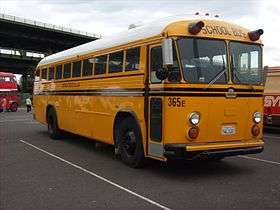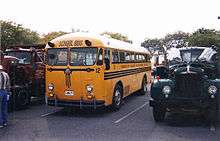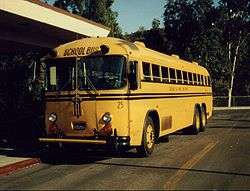Crown Supercoach
The Crown Supercoach is a bus that was constructed and marketed by Crown Coach Corporation from 1948 to 1991. While most examples were sold as yellow school buses, the Supercoach formed the basis for motorcoaches and other specialty vehicles using the same body and chassis. While technically available outside of the West Coast, nearly all Crown school buses were sold in California, Washington State, and Oregon.
| Crown Supercoach | |
|---|---|
 1977-1991 Supercoach (retired) at a UK bus rally | |
| Overview | |
| Type | Bus |
| Manufacturer | Crown Coach Corporation |
| Production | 1948-1991 |
| Body and chassis | |
| Class | |
| Doors | Single-door |
| Floor type | High-floor |
| Chassis | Crown Coach; underfloor or rear engine Single or tandem rear axles |
| Related | Crown Firecoach |
| Powertrain | |
| Engine | Gasoline
Hall-Scott Diesel CumminsDetroit Diesel Caterpillar |
| Capacity | 72-97 |
| Power output | 210-335 hp |
| Transmission | 4-speed automatic 6-speed automatic 5-speed manual 10-speed manual |
| Dimensions | |
| Length | 35-40 feet |
| Width | 96 inches |
| Chronology | |
| Predecessor | Crown Super Coach (1935-1948) |
From 1948 to 1984, the Supercoach was constructed at the Crown Coach facilities in Los Angeles, California; from 1984 to the 1991 closure of the company, the Supercoach was constructed in Chino, California.
Design History
1932-1948
In 1932, Crown Motor Carriage Company built its first complete school bus, in a shift from building bus bodies on cowled truck chassis.[1] Externally modeled after Twin Coach body designs,[2] the school bus body used a front-engine layout, with the Waukesha gasoline engine positioned next to the driver.[1] The body was of all-metal construction with an integrated chassis and safety glass;[2][3] for braking, in addition to the standard hydraulic service brakes, the Crown bus was equipped with a redundant hand-operated system alongside the standard parking/emergency brake.[1]
From 1932 to 1935, Crown Body and Coach Corporation produced additional forward-control school buses. As the original 1932 design proved too expensive to produce on a large scale, Crown shifted to a design based on a Reo commercial truck chassis.[1] Named the Metropolitan, while still a front-engine bus, the new design significantly decreased forward visibility.[2]
In 1935, Crown revisited the 1932 design, introducing a new version as the first Crown Super Coach. With a seating capacity of up to 76 students,[2] it was one of the largest school buses ever produced at the time. As with its 1932 predecessor, the 1935 Crown Super Coach featured an all-steel body with an integrated chassis, safety glass, and a front-engine body. In a big change, the redundant braking system was redesigned, with the Supercoach featuring full air brakes.[2][3]
In 1936, Crown produced the Super Coach as an intercity motorcoach, featuring onboard sleeper compartments. To maximize interior room, the powertrain layout was changed from front-engine to an underfloor mid-engine configuration.[1] In several variants, the Crown Super Coach would retain an underfloor layout through its 1991 discontinuation. In 1937, Crown would build the first mid-engine school bus, with a Hall-Scott gasoline engine; the change expanded capacity to 79 passengers.[1][2][3] To provide proper engine cooling, the bus was fitted with a front-mounted radiator.
In 1940, Crown Coach redesigned the Super Coach bus body and chassis, moving the engine to the rear.[2] Featuring a wider and taller interior, the Supercoach gained additional emergency exits (a rear exit window and right-side emergency door),[2] following the standardization of school bus dimensions and exits in 1939.
During World War II, Crown Coach produced few vehicles, with all production diverted towards military use.[1][2][3] In late 1945, Crown resumed production of Super Coach school and coach buses, struggling to meet demand.[1] To better ensure its survival after the war, Crown entered a joint venture with Indiana school bus manufacturer Wayne Works, becoming the West Coast distributor of its product lines.
1948-1960

In 1946, Crown began development on a new generation of vehicles. Starting life as a sightseeing bus for a motorcoach customer, the new-generation Supercoach (renamed as a single word) entered production in 1948, with Crown producing its first school bus example in late 1949.[1][3]
In a move back to the mid-engine layout, the design of the 1950 Crown Supercoach broke many precedents in school bus construction. Although built on a steel frame, to fight corrosion, the body panels of the Supercoach were of aluminum.[1] In place of the traditional ladder truck-style frame, the Supercoach featured a monocque-style integrated frame.[1]
In the early 1950s, Crown made several additions to the Supercoach model line. In 1951, the Crown Firecoach fire engine was introduced, heavily based on the mid-engine chassis of the Supercoach bus. At the same time, Crown began to explore other uses for the Supercoach; in 1954, several Crown Cargo Coach "brucks" were produced, combining the front body of a bus with the rear body of a van trailer.[1][2] Crown Security Coaches came into use as prison buses throughout the West Coast.[2]
In 1954, Crown introduced the first diesel-powered school bus, introducing the 743 cubic-inch Cummins NHH220 as an option.[2] For school districts with growing student populations, Crown introduced a tandem rear-axle Supercoach in 1955. Expanding the seating capacity from 79 to 91 (with a later option for 97), this would become the highest-capacity school bus ever mass-produced (alongside similar Gillig Transit Coach DT-models)[2][3]
To increase braking power, in 1956, Crown standardized 10-inch wide brake drums on all vehicles, the largest in the bus industry at the time.[2]
1960-1977

In 1960, the body of the Crown Supercoach underwent its first set of modifications since its introduction in late 1949. To enhance visibility, the windshield, driver window, and entry door windows were redesigned. To make the bus more visible, Crown moved the taillamps and brakelights from the doors of the luggage compartment towards the rear corners of the body.
Although overtaken by school bus production, Crown continued production of the Supercoach as an intercity coach in various lengths.[1] Designed similar to a GM Buffalo bus, the longest versions featured a raised deck over the luggage compartment; Crown also produced a bilevel coach similar to the GMC Scenicruiser in configuration.[1][3]
During the 1960s, Crown began to further expand its engine line. To aid the performance of its 91-passenger buses, a 262 hp turbocharged Cummins NHH was added. Alongside the Cummins diesel, an additional option included an underfloor version of the Detroit Diesel 671. In 1973, the 743 cubic-inch Cummins NHH diesel was replaced by the 855 cubic-inch NHH diesel, requiring internal structural updates to the frame. From the outside, 1973-1977 Crown school buses are distinguished by flat-topped wheel wells.
1977-1991

During the 1977 model year, federal regulations took effect that forever changed school bus design in the United States. To better protect passengers from crashes and rollovers, the structures of many school buses had to be updated; the metal-backed seats seen for decades were replaced by thickly padded, taller seats. Aside from the redesign of the passenger seats, which lead to minor capacity reductions, the structure of the Supercoach needed relatively few changes to meet the new regulations; the company claimed that the Supercoach was compliant as far back as 1950.[1] Post-1977 Supercoaches are distinguished by larger pillars behind the drivers' window and entry door as well as the fixed window next to the side emergency door.
In the late 1980s, along with the Crown Supercoach Series II, Crown began to expand the Supercoach lineup beyond its traditional two models. In 1988, a 38' version (84-passenger) was introduced. In 1989, two new 40' versions were introduced: a rear-engine and a single rear axle mid-engine.
In March 1991, Crown Coach closed its doors; the final vehicle produced was a 36-foot mid-engine Supercoach (with standard body).
Supercoach II (1989-1991)

Introduced during 1989, the Crown Supercoach II marked the most substantial revision of the Crown Supercoach body since it entered production in 1949. Designed for participation in a California Energy Commission program to study the feasibility of alternative-fuel school buses, the Supercoach II was fitted with both "advanced diesel" and methanol-fuel engines.[4][5] As part of the initial phase of the program, 153 Crown Coaches were purchased (103 diesel, 50 methanol).[4] As a secondary objective of the study, the buses researched the practicality of advanced safety features for school districts replacing buses manufactured before 1977.[4]
During the late 1980s, the only methanol-fuel engine that complied with California emissions standards was the Detroit Diesel 6V92. To mount the engine in the rear frame of the Crown Supercoach, significant modifications to the engine compartment were required, including a new rear floor and wider rear bodywork.[1][3] Along with redesigned lower bodywork to expand the engine compartment, the upper rear bodywork was redesigned, replacing the curved rear bulkhead with a vertical rear window, with a squared-off roofline. To match the redesign of the rear, the front bodywork was modified, with a squared-off roof above the windshield, an enlarged windshield (four-piece flat glass), and horizontal quad headlights. To maintain production commonality with the standard Crown Supercoach, the Supercoach II shared much of the bodywork between the entry door and rear seats with its predecessor. The drivers' compartment saw a major redesign, grouping secondary controls together left of the driver.
Following the production of the 153 CEC buses, the Supercoach II continued as a regular production model alongside the standard Crown Supercoach. In addition to the Detroit Diesel 6V92 diesel engine, the rear-engine Supercoach II was offered with the Cummins C8.3 inline-6 and the Caterpillar 3208 V8, along with the horizontal Detroit Diesel 671 of the mid-engine Supercoach. Produced primarily in a 40-foot rear-engine configuration, the Supercoach II was also offered in 38-foot lengths, in both rear and mid-engine configurations (no tandem-axle Supercoach IIs are ever known to have been produced).
During the 1990s, as the California Energy Commission program moved into its advanced stages, methanol was abandoned as an alternative fuel; virtually all of the 50 methanol-fueled Supercoach II vehicles were converted to operate on diesel fuel.
The Supercoach II was offered by Crown Coach through its closure in 1991; however, many of the 1991 vehicles produced by the Crown were of original Crown Supercoach body design. Following the closure of the company, the designs and tooling were acquired by Indiana-based Carpenter Body Works, which sought to restart production of the Supercoach II as part of its model line. Due to the complexity of the vehicle design, Carpenter was unable to produce the model at a competitive price, leading to the abandonment of the project. Several elements of the Supercoach II would live on in a successive product, the Carpenter/Spartan Coach RE, including its left-hand driver control panel and headlight layout.
Powertrain
| Engine | Configuration | Fuel | Production | Notes |
|---|---|---|---|---|
| Waukesha | Gasoline | |||
| Hall-Scott | 590 cu in (9.7 L) OHC I6
779 cu in (12.8 L) OHC I6 |
Gasoline | ||
| International Harvester | Gasoline | |||
| Ford Super Duty | 534 cu in (8.8 L) OHV V8 | Gasoline | ||
| Caterpillar 3208 | 636 cu in (10.4 L) V8 | Diesel | 1989-1990 | Rear-engine Supercoach II |
| Cummins 6C8.3 | 507 cu in (8.3 L) I6 | Diesel | 1989-1991 | Rear-engine Supercoach and Supercoach II |
| Cummins NHH | 743 cu in (12.2 L) I6
855 cu in (14.0 L) I6 |
Diesel | 1954-1972 (743)
1973-1991 (855) |
Mid-engine Supercoach; first diesel engine in a school bus
Available in naturally-aspirated and turbocharged configurations |
| Detroit Diesel 6V53 | 318 cu in (5.2 L) V6 | Diesel | 1961 | Produced as part of a customer-order rear-engine Crown Supercoach |
| Detroit Diesel 6-71/6L71 | 426 cu in (7.0 L) I6 | Diesel | c.1963-1991 | Mid-engine Supercoach; also produced for mid-engine Supercoach II
Available in naturally-aspirated and turbocharged configurations Also used in Crown-Ikarus buses. |
| Detroit Diesel 8V71 | 568 cu in (9.3 L) V8 | Diesel | Used in Crown motorcoaches; not used for school buses | |
| Detroit Diesel 6V92 | 552 cu in (9.0 L) V6 | Methanol
Diesel |
1989-1991 | Rear-engine Supercoach Series II, bus body designed for use of engine
Most methanol-fuel buses converted to diesel. |
| Detroit Diesel 8V92 | 736 cu in (12.1 L) V8 | Diesel | Used in Crown motorcoaches; not used for school buses |
References
- "Crown Coach, Crown Body & Coach Corp., Crown Carriage Co., Crown Motor Carriage Co., Crown Coach International, Crown Coach Inc., Crown Coach by Carpenter, Crown-Ikarus, Crown Aircraft, - Coachbult.com". www.coachbuilt.com. Retrieved 2017-03-09.
- "The Dentist Who Built Buses and Fire Engines by Ed Hass : Crown Coach Historical Society". Archived from the original on 2010-10-11. Retrieved 2017-03-09.
- "Crown Coach: California's Specialty Builder". buskidspage.tripod.com. Retrieved 2017-03-09.
- "SAFE SCHOOL BUS CLEAN FUEL EFFICIENCY DEMONSTRATION PROGRAM | Final Status Report Stage 4" (PDF). California Energy Commission. October 2002.
- Aldrich, Bob (February 1995). ABC's of Afv's: A Guide to Alternative Fuel Vehicles. DIANE Publishing. p. 66. ISBN 9780788145933.
california energy commission methanol school bus.
External links
| Wikimedia Commons has media related to Crown Supercoach buses. |